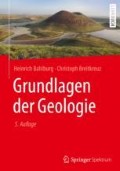Zusammenfassung
Die Diagenese überführt lockere Sedimente in Sedimentgesteine. Auch verwandelt sie die ins Sediment eingelagerte organische Materie pflanzlichen und tierischen Ursprungs unter geeigneten Bedingungen in Erdöl, Erdgas oder Kohle. Die Diageneseabläufe anorganischen und organischen Materials sind eng miteinander verbunden und von großer wirtschaftlicher Bedeutung nicht nur für die Kohle- und Kohlenwasserstoffreserven auf der Erde (Kap. 16). Erdöl, Erdgas und Kohle sind ebenso wie die Sedimentgesteine demnach die Produkte der Diagenese.
Literatur
Bahlburg H, Vervoort JD, Dufrane SA (2010) Plate tectonic significance of middle Cambrian and Ordovician siliciclastic rocks of the Bavarian Facies, Armorican Terrane Assemblage, Germany – U-Pb and Hf isotope evidence of detrital zircons. Gondwana Res 17:223–235
Bjørlykke K (2010) Petroleum Geoscience. From sedimentary environments to rock physics. Springer Verlag, Heidelberg, 340 S
Burley SD (1993) Models of burial diagenesis for deep exploration plays in Jurassic fault traps of the Central and Northern North Sea. In: Parker JR (Hrsg.) Petroleum Geology of Northwest Europe: Proceedings of the 4th Conference. The Geological Society, London, 1353–1375
Chapman RE (1976) Petroleum geology: a concise study. Elsevier, Amsterdam
Dickinson WR (1985) Interpreting provenance relations from detrital modes of sandstones. In: Zuffa GG (Hrsg.) Provenance of Arenites. 148, Nato ASI Series C148, 333–361
Dunham RJ (1962) Classification of carbonate rocks according to depositional texture. Am. Assoc. Petr. Geol. Mem. 1:108–121
Flügel E (1982) Microfacies analysis of limestones. Springer Verlag, Heidelberg, 633 S
Folk RL (1959) Practical petrographic classification of limestones. Am Assoc Petr Geol B 43:1–38
Füchtbauer H, Richter DK (1988) Karbonatgesteine. In: Füchtbauer H (Hrsg.) Sedimente und Sedimentgesteine. E. Schweizerbart’sche Verlagsbuchhandlung, Stuttgart, 1141 S
Potter PE (1994) Modern sands of South America. Geol Rundsch 83:212–232
Selley RC (1988) Applied Sedimentology. Academic Press, London, 446 S
Tissot B, Welte H (1984) Petroleum formation and occurrence. 2. Aufl. Springer Verlag, Heidelberg, 536 S
Wolf M (1988) Torf und Kohle. In: Füchtbauer H (Hrsg.) Sedimente und Sedimentgesteine. E. Schweizerbart‘sche Verlagsbuchhandlung (Nägele und Obermiller), Stuttgart, 683–730
Zeh A, Gerdes A (2010) Baltica- and Gondwana-derived sediments in the Mid-German Crystalline Rise (Central Europe): Implications for the closure of the Rheic ocean. Gondwana Res 17:254–263
Weiterführende Literatur
Chilingar GV, Buryakovsky L, Eremenko NA, Gorfunkel MV (2005) Geology and geochemistry of oil and gas. – Developments in Petroleum Science 52, Elsevier, Amsterdam, 390 S
Flügel E (2009) Microfacies of Carbonate Rocks: analysis, interpretation and application. Springer, Heidelberg, 1007 S
Füchtbauer H (Hrsg., 1988) Sedimente und Sedimentgesteine. E. Schweizerbart‘sche Verlagsbuchhandlung, Stuttgart, 1141 S
Gehrels G (2011) Detrital zircon U-Pb geochronology: Current methods and new opportunities. In: Busby C, Azor Pérez A (Hrsg.) Tectonics of Sedimentary Basins: Recent Advances. Wiley, New York, 47–62
Hunt JM (1995) Petroleum geochemistry and geology. 2. Aufl. W. H. Freeman, New York, 743 S
Littke R (1993) Deposition, Diagenesis and Weathering of Organic Matter-Rich Sediments. Springer Verlag, Heidelberg, 216 S
Mackenzie FT (2005) Sediments, Diagenesis, and Sedimentary Rocks: Treatise on Geochemistry: 7 (Treatise on Geochemistry). Elsevier, Amsterdam, 446 S
McIllreath L, Morrow DW (1990) Diagenesis. Geoscience Canada Reprint Series 4:338 S
Paquet H, Clauer N (1999) Soils and Sediments. Mineralogy and Geochemistry. Springer Verlag, Heidelberg, 369 S
Schäfer A (2005) Klastische Sedimente. Spektrum Akademischer Verlag, Heidelberg, 414 S
Tucker ME (1996) Methoden der Sedimentologie. Elsevier Spektrum Akademischer Verlag, Heidelberg, 366 S
Tucker ME, Wright VP (1990) Carbonate Sedimentology. Blackwell, Oxford, 482 S
Welte DH, Horsfield B, Baker DR (1997) Petroleum and Basin Evolution. Springer Verlag, Heidelberg, 535 S
Author information
Authors and Affiliations
Rights and permissions
Copyright information
© 2017 Springer-Verlag GmbH Deutschland
About this chapter
Cite this chapter
Bahlburg, H., Breitkreuz, C. (2017). Diagenese und Einteilung der Sedimentgesteine. In: Grundlagen der Geologie. Springer Spektrum, Berlin, Heidelberg. https://doi.org/10.1007/978-3-662-54931-5_8
Download citation
DOI: https://doi.org/10.1007/978-3-662-54931-5_8
Published:
Publisher Name: Springer Spektrum, Berlin, Heidelberg
Print ISBN: 978-3-662-54930-8
Online ISBN: 978-3-662-54931-5
eBook Packages: Life Science and Basic Disciplines (German Language)

